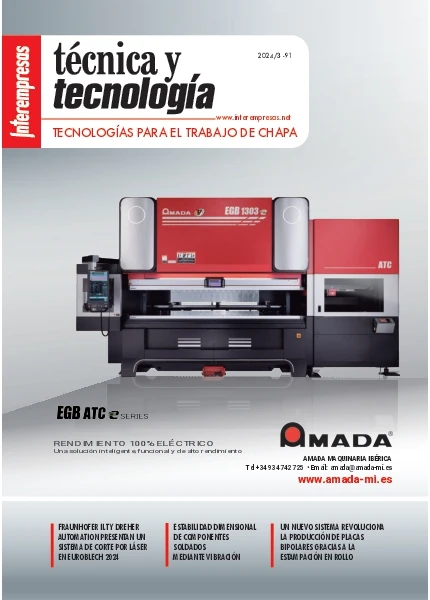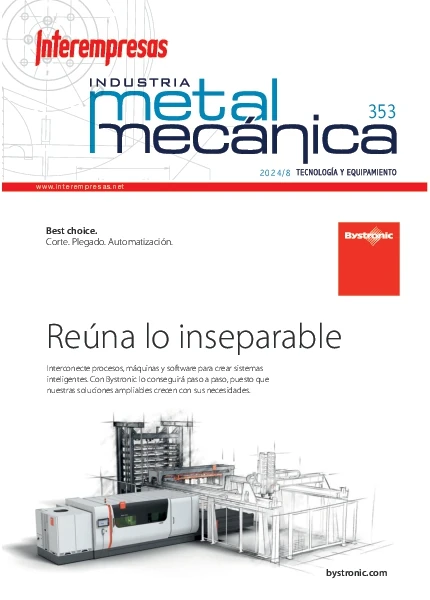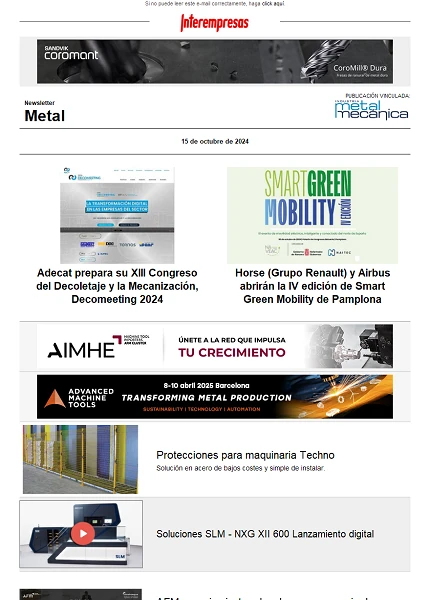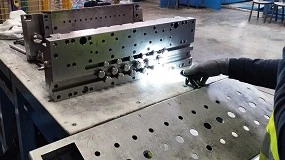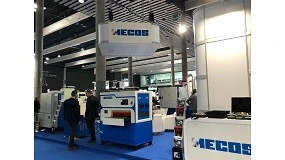Technological opportunities in agriculture under plastic
July 21, 2009
Opportunities, threats and challenges
Agriculture under plastic in Spain is facing a number of opportunities:
• New markets, such as those that open with the enlargement of the European Union.
• The evolution of the consumption habits of vegetables to more elaborate or specific to certain segments of population products: vegetarian consumers, ethnic products, etc.
• The use of greenhouses plastic for new applications, such as aquaculture, the production of energy or the desalination of water.
• Additional income by bonds of uptake of CO2.
The threats that face are:
• The disappearance of protectionist barriers in the market at the beginning of the next decade.
• Competition from countries with lower costs of labor, such as Morocco or Turkey.
The remaining challenges are:
• Environmental sustainability, implying the need to reduce energy and water consumption and waste generation, as well as increase the use of renewable resources: wind, solar, geothermal, biomass, etc.
• Social sustainability, with the consequent need to improve the working conditions of workers in the greenhouses.
All they can respond through technological developments to improve the quantity, quality and time of production of crops with less use of non-renewable energy and water, lower requirements of agrochemicals and unskilled labour. These technologies can be classified into three groups:
• New materials for roofs, structures and substrates.
• Electro-mechanical for task automation, improves the air conditioning (heat, cold, carbonic fertilization, artificial lighting) and fertirrigation.
• Biological systems auxiliary for pollination and integrated control.
New materials: cover
The technological opportunities on plastics for greenhouses cover through the development and use of new covers enabling higher productivity and better control of the climate of the greenhouse to get crops in the most advantageous times economically (maturity)(, late production, quality, etc.) Likewise, it will be necessary to cover materials adapt to the new developments taking place in structures (greenhouses with mobile cover) or in systems of cultivation (integrated production).
There are a number of films:
· Films with blocking ultraviolet (UV) (antiplagas): this type of films fotoselectivos protect crops of different diseases and pests, by what are known as antiplagas films, antivirus or antibotrytis, which allows less intensive use of chemical pesticides. So far its use has been limited due to the perception by users that may interfere with the activity of pollinators. Since recent studies have shown that this interference does not exist or is easily avoidable, it is likely that its use will spread in the coming years. We must also study the effect of this type of roof on the activity of the auxiliary fauna in the greenhouses made integrated control.
· Films with locking in the near infrared, (Near Infrared Radiation NIR) (antitérmicos): also are films fotoselectivos in this case, that block the infrared radiation near the visible of the solar spectrum, avoiding daytime overheating of the greenhouse and allowing crops in tropical or desert areas or in warm periods in other areaswhere they were wasteful with other technologies. This type of roof will certainly be a good addition to other techniques of cooling, such as the lime, the atomization, etc. It will be necessary to develop specific decks for different climates and crops, since both the NIR blockade and reduction in transmission pair (Photosynthetic Active Radiation 400-700 nanometers) that sometimes has been associated, should be adjusted to the local climatic conditions.
· Fluorescent films: alter the quality of sunlight, with regard to its spectral distribution, in the ultraviolet and visible part of the spectrum, absorbing little use for the plant (green and ultraviolet) wavelengths and emitting it in others more exploitable for photosynthesis (blue and red), with what would be increases in production and improvement of the quality of the vintage. So far it has been observed that the effects of this type of roof are not universal on all crops, but both the production and the morphology of the crops (stem length, number of flowers, etc.) depend on cultivationeven of the variety cultivated. Therefore, more effort of development and adaptation of these covers emission characteristics to specific crops and areas will be necessary.
Ultratérmicos films: presents an exceptional opacity to the infrared part of the emission spectrum of the Earth, keeping the temperature in the greenhouse during night and allow significant savings in the use of heating (10-30%). They therefore allow crops in cold areas, where with other cover materials would not be profitable; It is expected that use is increasing as its features are being known to farmers and that extends the use of heating in Spanish greenhouses. In general, the greenhouse, both films and rigid plates and mesh cover materials, are subject to degradation of their properties due to environmental factors (light, heat, pesticides, etc.), so it is necessary to evaluate and, where possibleadvance, its properties over time. This is done through natural and accelerated ageing tests. Traditional methods of accelerated aging have reduced acceleration factors and important limitations when it comes to reproduce the actual field conditions. The development of new experimental systems, to shorten these testing times, is a necessity in the industry sector.
Structure of the greenhouses
The structures of the greenhouses that are built today combines wood and wire, in older structures, and metal elements in the most modern. These materials meet the basic requirements of the application, with reasonable cost, so it is not expected that they are displaced by other new materials in the short term.
Where can it be news is in the types of used structures. Thus, need to improve the climate control of greenhouses will probably lead to greater use of structures with good ventilation and allowing the alternative use of various types of roofs or materials of shading - mobile roofs, systems for full opening of the cover, etc. — and, at the same time, to improve the tightness and thermal insulation in the times in which necessary artificial heating or carbonic fertilization (technique enrich with CO2 for photosynthesis). The trend is to use structures with a better ventilation, which is achieved with the increase in the height, the increase in the number and the section of the Windows, and for the optimization of its placement and opening systemas well as the use of elements deflectors of air currents that allow to optimize the environmental conditions at the height of the plants. Computational fluid dynamics Computational Fluid Dynamics (CFD), which more and more groups of research and manufacturers of structures being used for this application is a tool that allows you to optimize resources and improve the design of structures.
Also a still incipient trend to increase the percentage of area cultivated in the greenhouse is detected either by reducing corridors (high crops), cultivated in stacked form when cultivation permits, taking advantage of the surface/volume that is below the main crop for other cultivation (aquaculture)aeroponía (crops in air) and presoponía (plants without roots).
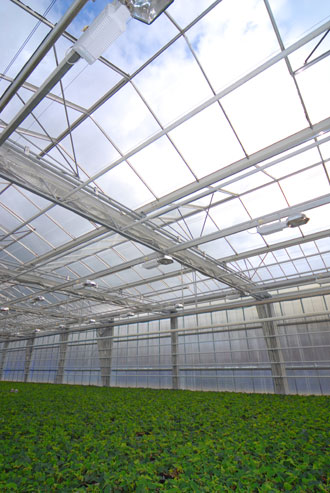
Substrates
Substrate crops have several advantages over the cultivation in soil: reduce the incidence of diseases, facilitate the collection and recirculation of water lixiviada and offer a good economic performance (increased production and early maturity). On the other hand, have some drawbacks: higher cost of installation, requirement of a high technological level and low inertia of the system.
Another disadvantage to note is the waste of these substrates, whose recycling depends on the type of substrate, but which in general is difficult. The materials used as substrates must have a number of features:
• Physical properties, such as high porosity, retention and availability of water and aeration.
• Chemical properties: they must be free of toxic substances such as heavy metals, and must be chemically inert, something that does not comply with organic materials.
• Biological properties: must be of low biodegradability, something which comply with the inorganic materials and organic with relation to the carbon/nitrogen between 20 and 40.
The tendency to increase the cultivation on substrate will continue in the coming years and easily recyclable materials will be moved to those that are not, such as perlite (volcanic origin consisting mainly of silicates ore) or the Rockwool (mineral wool manufactured from basaltic rocks).1 are testing different alternatives, ranging from materials of natural origin such as rice husks, coconut fibre, pomace of grape or Poseidonia oceanica, until synthetic such as polyurethane foams, although none of them had been introduced extensively at this time. The pure hydroponic, without substrate, can also be an alternative, but requires a more sophisticated control system.
Electromagnetic systems: mechanization
There are two lessons that do travel processes of industrial production processes of production in greenhouse in order to improve efficiency and production speed and quality of products and working conditions:
• Workers have been equipped with mechanical tools for the job or the labour force has been replaced by machines.
• Product (car, television, or plant) moves through a conveyor to the post of labor, where the worker has one or a small number of tasks that run in a clean and well organized environment.
There are two levels of mechanization which can be applied to the tasks of a greenhouse, which are often referred to as Robotics and industrial automation or mechanization of high-tech, although, in practice, the border is often fuzzy. The first is characterized because:
• Replaces human activities in simple tasks.
• Does not have much flexibility regarding the tasks to be performed, manageable products or environment in which unfolds.
• Uses few sensors.
• No shows (adaptable to different situations or contingencies) "smart" behavior.
• It is usually a purely mechanical system.
Greenhouses can be found machines based on mechanical solutions capable of performing the same task over and over again; machines for sowing, transplant, grafting, the application of pesticides, classification and packaging. The second is characterized because:
• It is capable of more than one task and your system is reprogrammable.
• It is flexible to handle products or the environment in which we work.
• Uses many technologically more advanced sensors (treatment of images, spectrophotometers, etc.).
• Presents (adaptable to different situations or contingencies) "intelligent" behavior.
• Is based on a combination of mechanics and electronics.
The robotization and automation of high technology is virtually non-existent in Spanish greenhouses and begins to appear in more advanced countries, such as Holland. The concept of moving the plant until the worker, and not to the contrary, is used in the Netherlands for some years for plants grown in pot and presents a number of advantages:
• Reduces the cost of labour.
• Optimize the utilization of the space of the greenhouse.
• Increases efficiency in the processing of the harvest and reduces emissions.
• Improves the conditions of work (temperature, humidity, light), because they can be adapted to the optimum for the worker.
• Facilitates monitoring and traceability during production to ensure quality and safety of products.
• Facilitates the automation of tasks.
Some examples of automatable tasks are the following:
• Planting.
• Graft.
• Transplant.
• Mobile cropping systems.
• Application of pesticides.
• Training (placement of a bra to vegetables from stems, climbing or crawling, to prevent its contact with the ground, promote the ventilation and lighting of the plant and the work of irrigation, weeding, harvesting, etc.).
• Harvested from plants of leaf.
• Harvested fruit plants.
• Harvested flowers.
• Leaves.
• Classification of vegetables.
• Classification of flowers.
• Packaging.
Especially the early stages of the cycle of cultivation (production of seedlings and transplants) and the last (classification and packaging, and to a lesser extent the harvest) can be machined. On the other hand, the middle stages of maintenance of the crop, are harder machinable. Usually the simplest tasks ones following the principles of industrial automation. The phases are not machinable require some human skill special or, in other words, are difficult for people. These are tasks which require 'ojo-mano' quick and accurate processing of much information on the size, shape, color and position and a coordination. Most of the maintenance tasks, as well as some stages of sorting and packaging, are in this category.
In the near future, it is hoped that the existing machinery be improved to develop its work with greater speed and efficiency. These advances will be based mainly on those that occur in the industrial automation. On the other hand, it is hoped that a new generation of machines go replacing people in increasingly complex tasks. The existence, development, or commercial phase of robots for the graft, the harvested roses and strawberries and the leaves of tomato announce changes in that regard. However, this type of innovation is often delayed between five and ten years, since the initial idea until that it reaches the market. Therefore, it is not expected a revolutionary in the next years change, unless circumstances not provided for, such as a shortage of labour.
The air conditioning
The use of active air conditioning systems is still limited in Spain. However, these systems allow to manage the crop in such a way that it can optimize economic performance, both in times of higher value crops obtaining and improving the quality. Sometimes, in the absence of heating can be the complete loss of a crop in the event of frost. The methods currently used to heat greenhouses are often based on an active energy source of fossil, diesel fuel or liquefied petroleum (propane) gas.
The heating can be provided by heating the air greenhouse or via hot water pipes installed at the level of cultivation. Heating hot air is used to raise the temperature of the greenhouses. Heating by hot air is to move air through heat pockets and then push it into the atmosphere of the Conservatory. There are two systems:
• Direct combustion generators. The flow of air that is introduced in the greenhouse heated pouring therein the combustion products. Most of the models used in greenhouses takes the interior air for combustion, although other models allow an entry of outside air to reduce the concentration of CO and CO2. The performance of these teams is full (100%), because all the heat is introduced in the greenhouse. On the other hand, only they can be used with propane or natural gas, and not with diesel, due to azufrados compounds arising from the latter.
• Generators with heat exchanger or indirectly. The flow of air that is introduced in the greenhouse does not pass through the combustion chamber, but it is heated in a heat exchanger. The products of combustion evacuate abroad by a fireplace, which leads to loss of energy.
Hot air generators can be installed inside or outside the greenhouse, in which case there is to drive the warm air. Inside the greenhouse, you can install ducts of perforated sheet metal or plastic to distribute air evenly, or put several lower power generators. Also small fans (recirculating) inside the greenhouse to homogenize the temperature can be placed.
Normally the spent fuel is diesel or propane, and teams are equipped with an electric ignition system driven via a thermostat. Heating by hot air systems have the advantages of its minor economic investment, greater versatility, rapid response and ability to reduce the humidity, to facilitate disease control.
As disadvantages include the following:
• Provide a poor distribution of heat, sometimes creating internal turbulence causing heat losses (less thermal inertia and uniformity).
• Its operation cost is high, and if they break down, the temperature drops rapidly.
• Its thermal inertia is limited.
Hot water heat distribution systems are based on pipes that can be installed at the level of cultivation, buried, or the sidewalk (supports on which they become substrates). The characteristics of the hot water system that most stand out, are:
• To be the heat applied at the base, the temperature of the air of the greenhouse is much more uniform in comparison with the traditional heating by hot tube hanging from the ceiling.
• Are more efficient than air systems. Energy consumption is generally lower.
• Installation costs are high. Low temperature (30 to 40 ° C) systems have the following characteristics:
• Are likely to take advantage of the industrial residual heat from cogeneration or other industrial process and solar energy at low temperature.
• Economic materials such as polyethylene rather than pipes more expensive steel or aluminum can be used. General soil heating systems represent a saving of energy.
To produce hot water are usually used boilers diesel, propane and, sometimes, natural gas, while the trend is to go by replacing fossil fuels with renewable energy. In greenhouses with highest level of technification, both hot air generators and boilers can be replaced by driven heat pumps with propane or gas natural, more efficient and capable, moreover, provide cooling, installation costs are significantly higher.
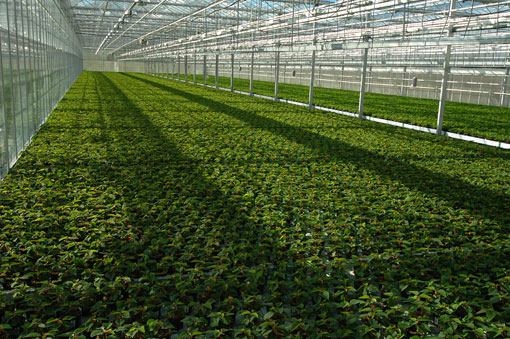
Thermal screens
You can define a screen as an element that, extended to cover mode on crops, has as main function provide shade and/or retain heat.
The use of thermal screens get ductivos pro increases of up to 30%, thanks to the ability to maintain during the night the heat picked up during the day. The screens are also useful as a double cover which prevents direct drip from condensation of water on plants in times of excessive moisture. Thus thermal screens can be used for different purposes:
• External protection against:
-the excess of direct radiation on plants;
-the excess of temperature;
-secondarily, against wind, hail, birds, and so on.
• Internal protection:
-thermal protection, energy saving;
-secondarily, humidity and condensation.
There are different types of screens, while most have a base woven with synthetic yarns and aluminium sheets. There are also displays that are directly woven sheets of reflective material among themselves or with another type of plastic sheet (polyester, polypropylene, etc.). Composition, arrangement, and thickness of the elements is variable, offering different characteristics of transmission of visible light and heat retention, that allow to adapt the climate inside the greenhouse to a growing and climatic zone specific.
Also, as regards the flow of air, screens can be open or ventilated and closed or not ventilated. Open ones have the advantage of being very useful in the summer to allow the evacuation of the excess of temperature and offer thermal properties, reflecting much of the infrared radiation during the night. Closed screens limited losses by convection of heat in the air and reduce the volume of air to be heated, with what the savings with regard to the heating is greater.
The cooling
The big problem of the greenhouses in the Mediterranean area appears in the warm periods, mainly in summer.The greenhouse effect produces a warming of the climate inside, and can reach temperatures higher than 50 ° C, which is very detrimental for cultivation and personal charge of her care. In a lot of places, it is very common to not produce in greenhouses during the months of July and August due to this problem.
The methods currently used for cooling greenhouses are as follows:
• Ventilation, which is the most widely used in practice cooling technique. To renew the air it acts on the temperature, humidity and the content of CO2 in the interior of the greenhouse. Ventilation can be done in a way natural or forced. Heat levels that are achieved are inadequate.
• Systems of shading, also widely used. There are two types: static and dynamic. In general they are not very effective, because they manage to reduce the temperature few degrees, leaving still excessive levels, although they are very cheap.
• Cooling by evaporation of water. It consists of distributing a large number of micro liquid water close to 10 micrometres size in the air. It is necessary to use an atomization system consisting of a set of nozzles nebulizadoras connected to pipes that hang from the roof of the greenhouse. The installation is complete with pumps, engines, nozzles, filters and control equipment, thermostats, regulators of humidity, etc.), which allow the automation of the system. It is an expensive system, although less and less, that manages to bring down the temperature about 10 to 15 ° C.
• Evaporator screen (Hidrocooling or Cooling System). This is a screen of porous material that becomes saturated water through irrigation equipment. The air passes through the porous screen, absorbs moisture and low temperature cooling the greenhouse to pass him. He is subsequently expelled by some fans. With the 'cooling system' the temperature inside the greenhouse can be reduced by up to 10 ° C while it is normal that the decline is 4-6 ° c. If the humidity of the outside is high, this system does not work properly.
• Systems of active cooling (air conditioning) heat pumps so far have been unworkable, because of the electric power demand can not be provided with the electrical infrastructure available to the greenhouses, where they have it. Air conditioning to gas (propane or natural gas) with a minimum consumption of electricity, which it can be installed in greenhouses, although both installation and operation costs are high are currently on the market. An additional advantage of these teams is also provided by heating with an efficiency higher than traditional boilers and generators of air teams. Cooling with heat pumps can apply cooling the air of the greenhouse through a system of cold water pipes. If the greenhouse has a system of pipes for heating by hot water, in the majority of cases it be used for cooling making circular water between 7 and 15 ° C.
There are several possibilities for cooling the greenhouses, although none get itself completely objective and requires combinations of several of the possibilities discussed above requiring very high maintenance and investment. However, in warm periods in very sunny areas, as the South of the peninsula, the temperature levels remain high and punishing crops, with negative results both in the amount, not to produce everything that should be, as in quality. This happens in warm but not extreme, periods in which the production is abandoned. Today there are lines of research looking for solutions based on solar energy for the needs of heating and cooling of the greenhouses.
Carbonic fertilization
Carbonic fertilization is called the complementary contribution of carbon dioxide in the crops.
• If CO2 is applied in the environment surrounding the plant, it is atmospheric carbonic fertilization.
• If the CO2 is injected into the system of irrigation is carbonic irrigation fertilization, but this system has generated controversy.
These methods can be used separately or combined, depending on the characteristics of the crop: plant variety, technique of cultivation in closed greenhouse, open fields, etc. Carbonic fertilization benefits are as follows:
• Increases the production and the crop yields, around 25-30%.
• Allows to bring forward the time of collection (maturity of crops), approximately 20%.
• Improving the quality of fruits and flowers (density by plant, coloration, size, etc.).
• Acidifies the soil, optimizing the assimilation of nutrients and metabolic activity.
• Allows late sowings without delay of harvests.
• Increases the resistance to pests and diseases, reducing spending on agro-chemicals (environmental improvement).
• Prevents inlays on the drippers, reducing maintenance costs.
• Improves the profitability and the added value of products with a minimum investment
• It is a way of capturing CO2, which contributes to the effort of the major industrialized countries to reduce emissions that cause climate change on the planet (Kyoto Protocol).
In greenhouses without artificial input of carbon dioxide, the concentration of this gas is highly variable throughout the day: reaches the maximum of its concentration at the end of the night and the minimum hours of maximum lightthat they are consistent with the noon. Levels advised of CO2 depend of the species or variety cultivated, solar radiation, ventilation, temperature and humidity. With regard to the light and humidity, each plant species has a different optimal. The fertilization with CO2 is still a nascent technology, so it is necessary to carry out an exhaustive investigation in this regard, since it is expected a great potential in the coming years.
Artificial lighting
Sometimes it is beneficial to apply artificial or simply regular lighting natural lighting in the interior of the greenhouse for the following purposes:
• Force greater efficiency in photosynthesis, during the winter months. The extra otoño-invernal lighting helps increase production yields in most of the horticultural species and numerous ornamental.
• Increase the length of the day, in long day plants that not florecerían otherwise, during the autumn and winter.
• Break the continuity of the dark hours in ornamental plants in those periods of short day, in order to help the vegetative growth at a time in that would benefit the flowering while plants have the proper size, either to trigger flowering in plants of long in times of low light day.
• Reduce the light intensity in summer sowing of vegetables.
• Reduce the duration of the illuminated, with the end of that short day plants can flourish in times in which the duration of daylight hours is too high. However, not all artificial light sources have the same efficiency in terms of quality of the light emitted. This is due to the light (colloquial name which defines the zone the electromagnetic spectrum perceivable by the human eye) are classified according to wavelength. Certain wavelengths are which take better advantage of plants to perform their vital functions, mainly for the blue and red, while others just have effects. Therefore, if artificial lighting is used, it has supplied with lamps that provide appropriate wavelengths. In addition to visible light, also have some influence on the development of the plants the next infrared and ultraviolet. The main artificial lighting systems are the following:
• Incandescent lamps: are the traditional light bulbs. They produce visible and infrared light. They give off much heat and consume large amount of electricity, so its luminous performance is very low. They can also burn the plants if they are too close. The system is cheaper, but not recommended. They are used in practice to interrupt the photoperiod.
• Mercury vapour lamps (MV): produce light (white, blue and green). Used during the growth of plants by their high emission in the blue area of the spectrum, but they are poor in the red zone, which is why not promote flowering. They are very efficient in the use of electricity.
• Mixed lamps (incandescent and mercury vapour): thus get the necessary red radiation for the stimulation of the flowering of the plants in inside. The problem is that its use has a high cost.
• Fluorescent: produce light (mostly blue and red, although much depends on the type). They are especially recommended during the early stages of the plant. They are quite economic, high light yield and do not emit too much heat. The main problem is that they take up much space.
• Metal halide (MH) lamps: produce a white light, slightly bluish, very suitable for germination, vegetative growth and the rooting of cuttings. They are cheaper than mercury lamps, but they have lower performance.
• High-pressure (HPS) sodium vapour discharge lamps: produce light (yellow and anarajanda). Without a doubt are the best, because they emit more light and less heat. They provide the entire spectrum of light necessary for the growth and flowering of the plants. They are very efficient in the use of electricity and the price is reasonable.
• The development of LEDs (Light-Emitting Diodes), presenting a greater efficiency of light emission by energy consumption than conventional sources, with monochromatic emission spectra and whose price is down significantly, can make a technological leap over the coming years.
So far the use of artificial lighting has only demonstrated profitability for ornamental crops with high added value in conditions where natural light is not enough, as with the current energy cost electricity consumption does not compensate for the shortening of the observed growing cycles. It is predictable that it extends to the horticultural crops in the short term.
Fertigation
Fertirrigation is intended to optimize the use of water and fertilizer, partly in order to reduce costs of crop, but above all to prevent soil and water pollution from fertilizers, as well as to minimize the problem involving the scarcity of water for the intensive agriculture of the South and East peninsular. There are two current trends that are becoming more important:
• The manufacture of liquid fertilizers for Fertigation: specific formulations for a crop and State phenological or even for a farmer in particular, of great wealth and high concentration. Makes it easier to the farmer, since that may have prepared fertilizer factory solutions, with which does not have to worry about filling tanks, make calculations, store significant amounts of soluble fertilizer, etc.
• Recirculation of drainage in cultivation without soil: technique that allows the recovery of drains produced by vegetation, for reuse on the own cultivation. It is a great saving of water and fertilizers (approximately between 40 and 50 per cent of fertilising elements), and avoid that they are going to stop to aquifers, with the consequent danger of contamination of the same, because if the drained water is recirculatedIt is a time critical and delicate to proceed to their treatment to prevent the spread of diseases.
Auxiliary biological systems
The potential value of bumblebees as pollinators insect in agriculture has been recognized since a long time by various authors, who have also highlighted that the exploitation of this potential should be based not only on the spread of natural populations (for example)(, by improving the Habitat or through the introduction of artificial breeding boxes), but also on its domestication. Attempts at domestication have a long history, but it was not until the 1970s when it became a fact. However, once achieved, it was not until 1985 when the value of the Bumblebee for pollination in greenhouses for tomatoes in Belgium was found. Until that time, the flowers of tomato in greenhouses Belgian and Dutch polinizaban mechanically, making vibrate the plant three times per week (with a cost of 10,000 euros per hectare per year), and in other countries used this same mechanism or hormones, in a comparable frequency.
Since the beginning of the commercial breeding, in 1987, produces a million annual of five species of bumblebees hives; the most important are ' Bombus terrestris' from Eurasia, and ' Bombus impatiens'. The use of bumblebees as pollinators has spread to all kinds of vegetables and fruit crops with attractive floral characteristics for these insects. Bees can also pollinate almost the same crops, but are often less efficient than bumblebees. Still, the choice depends on, occasionally, local costs and weather conditions. Both greenhouse and field, the bumblebees hives can be managed more easily than the hives of bees and are also preferable when temperature and/or light intensity are low. Usually the bees forage not when the air temperature is less than 16 ° C, while bumblebees remain active at temperatures below 10 ° C. Bumblebees leave of forage when the temperature exceeds 32 ° C (in the case of B. terrestris), because, although they can fly rapidly at temperatures of 35 ° C, stay in the nest to vent to the breeding and avoid dying by excess heat. On the other hand, a long tongue and a larger body, unlike the honey bee, allow that the Bumblebee is better pollinators of flowers with deep Corollas, and, with only a single visit to the flower, it leaves sufficient pollen to perform a successful pollination. In addition, their ability to vibrate the stamens of the flower, something impossible to honey bees, lets you be a good Pollinator for flowers with morphology similar to the of the tomato. So far, the use of bumblebees in the Spanish fruit and vegetable crops is extended to invernadas surfaces of the Andalusian Levant, Murcia and Granada, mainly. However, while crops such as tomatoes, peppers and eggplant, of high economic value, and are pollinated by insects, there are others - is the case of the strawberry and the zucchini-which are a clear challenge for the coming years.

Integrated production
The integrated pest control, biological control as main component, is especially necessary in the vegetables under plastic, since that is for consumption as fresh products, what waste can reach more directly to the consumer. Mediterranean gardening is also a system of production very tensivo in, with a high consumption of plant protection, and horticultural areas often are concentrated in peri-urban areas.
On the other hand, the resistance of main pests to the active ingredients has led to uncontrolled of plant protection products use and increasing waste in them, with the consequent loss of confidence of the customers in other European countries and also of the national. For this reason the market has become very strict with regard to waste, requiring even occasionally lower limits that the marking legislation. The establishment of the biological control on a large scale in Almería has regained that trust and there is no turning back towards conventional chemical methods.
This turnaround has allowed the emergence of local companies with production of natural enemies and bumblebees, which technically gives great impetus to the development of biological control systems in general and encourage research and development of wildlife Assistant native. He is expected, for example, that in the coming years in the greenhouses of the province of Almería are made more loose of natural enemies that in horticultural crops throughout the rest of Europe.
One of the outstanding tasks is to further develop indigenous species that are better adapted to local conditions. At the beginning, the majority of species selected for biological control in protected cultivation were adapted to the conditions of Central European countries. However, since 2001 developed the commercial farming of native species, better adapted to local conditions. Some of the most relevant examples are the parasitoid ' Eretmocerus mundus' and the Predator ' Nesidiocoris tenuis'. Both species have significantly contributed to the success of biological control and are being used on crops protected from Spanish South-East and the Canary Islands.
In general, biological control it is working successfully, but there is still much work to be done. It is pepper where better management is made of natural enemies, being the biggest problem the Lepidoptera. Tomato control red spider and vasates is the biggest problem, although it is hoped, for the following campaigns, an increase in the use of auxiliary. In the cultivation of Eggplant biological control is on the rise, exist variations in the control of thrips and whitefly. There has been a good control of whitefly and trips through loose in cucumber of ' Amblyseius swirskii'. Zucchini the results are also successful, allowing the use of pollinators, which until now had been hindered by the use of hormones fitorreguladoras for pollination. In short, such as melon and watermelon-cycle crops, the biggest problem is the CDF that is well controlled with auxiliary fauna.
Other uncertainties that it must be clarified are, for example, the possible emergence of new secondary pests associated with the reduction of plant protection treatments. In addition, there are still some pests for which no biological solutions are available. For example, the noctuid and recent exotic pests as 'Tuta absoluta'. Recently, a new indigenous predator, has developed ' Nabis pseudoferus ibericus', which has given excellent results as these pest control agent.


